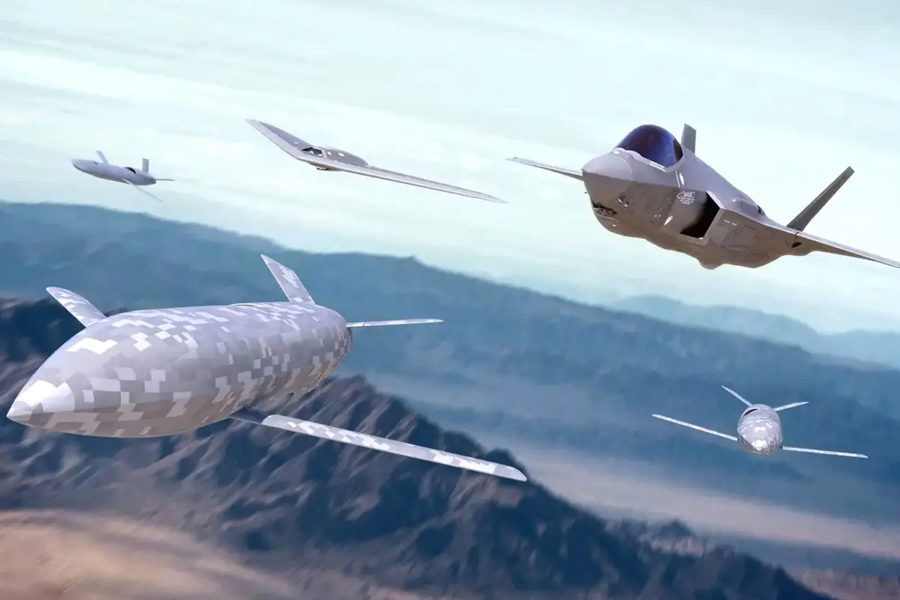With the Air Force poised to pour significant resources into its Collaborative Combat Aircraft (CCA) program, the service shouldn’t become fixated on a particular price point for each of the unmanned aircraft to the point of neglecting capability or reliability, two of the generals helping lead the program’s development said Dec. 14.
Maj. Gen. Scott Jobe, director of plans, programs, and requirements for Air Combat Command, and Brig. Gen. Dale R. White, the USAF’s program executive officer for fighters and advanced aircraft, both addressed the issue of cost for CCAs as part of a virtual rollout for a Mitchell Institute report.
That report, authored by Caitlin Lee and retired Col. Mark Gunzinger, was based off a three-day workshop hosted by the Mitchell Institute that brought together Air Force and industry leaders, planners, and operators to consider the kinds of autonomous collaborative platforms the service should focus on building.
The report found that workshop participants generally favored larger quantities of drones, even if it meant trading off some capability. That finding was based on what the authors admitted was a generally “optimistic” assumption that such drones would cost roughly $1,000 per pound—far less than most manned platforms today, and a cost that experts believe could be accurate in the future but lack the real-world data to confirm.
“We do need to get after this cost assessment issue—what is the right cost per pound? And we need the data to prove it out,” Lee noted in presenting the report’s recommendation.
The question of just how much the Air Force would be willing to spend on these CCAs isn’t completely answered, but Air Force Secretary Frank Kendall has offered at least something of an upper limit, saying earlier this year he’d like a system with half the cost or less of next-generation manned platforms like the B-21 bomber or Next-Generation Air Dominance fighter.
Such a standard could still mean CCAs that cost tens of millions of dollars. But White, who will oversee much of the acquisition process for the platforms, warned against fixating too much on price.
“The Secretary has said … he would expect this to be about half the cost of a crewed aircraft … half the cost of an F-35,” White noted. “Those are some of the bounds people are putting on it, but I think there’s danger in that. Because then you start building to an expected number, when in reality what you need to do is be building to a capability. And then you need to decide whether or not that number is too high and it doesn’t build in that cost imposition you’d want.”
Acknowledging that price will “drive the decision space” on CCAs, White said that affordability will continue to be a “driving factor” in how the program is developed. But beyond that, he stressed the importance of cost imposition—the effect of creating problems or dilemmas for an adversary—as something that must be considered.
“One thing Gen. Jobe and I talk about a lot, and I think this is critically important, is we can’t lose sight of the fact that cost imposition is important,” White said.
Jobe also stressed the importance of return on investment—ensuring the right effects for the right cost. And the baseline for that, he added, is ensuring that when an Airman “is out there on that leading edge and he’s force packaging up and he’s going to count on a large swarm of CCAs to show up—if they don’t show up because of reliability problems, we got the cost too low.”
There are other factors to consider as well—the more complex and expensive the aircraft becomes, the longer it will take to develop and build, White noted. And speed has been a priority for CCA, with various leaders calling for the drones to be quickly fielded and then iterated upon. It’s an approach Jobe is taking while developing program requirements—his goal, he said is that they be “flexible, fungible and will develop rapidly over time.”
Neither general could offer concrete timelines and costs for CCAs, but White offered a hint that as the 2024 budget and more gets rolled out next year, those details will start to become clear.
“As we start getting more into the discussion of the budgets rolling out, we’re going to have probably a greater conversation about what that number looks like,” White said. “And I don’t think we should fix that number either. That’s the other thing. It’s not going to be just a single number because there may be some times you’re going to want some of these systems to be a little more complex and a little less attritable.”
